

Compact Muon Solenoid
LHC, CERN
| CMS-PAS-HIG-19-001 | ||
| Measurements of properties of the Higgs boson in the four-lepton final state in proton-proton collisions at √s= 13 TeV | ||
| CMS Collaboration | ||
| March 2019 | ||
| Abstract: Properties of the Higgs (H) boson are measured in the H→ZZ→4ℓ (ℓ= e, μ) decay channel. The full data sample of proton-proton collisions at a center-of-mass energy of 13 TeV is used, corresponding to an integrated luminosity of 137.1 fb−1 recorded in 2016, 2017, and 2018 by the CMS detector at the LHC. The signal-strength modifier μ, defined as the ratio of the H boson rate in the 4ℓ channel to the Standard Model (SM) expectation, is measured to be μ= 0.94+0.07−0.07(stat.)+0.08−0.07(syst.) with the H boson mass profiled in the fit. The signal-strength modifiers for different H boson production modes are also constrained. Measurements of the simplified template cross sections, designed to quantify the different H boson production processes in specific regions of phase space, are reported. The cross section for the production of the H→4ℓ in a fiducial region closely matching the experimental selection of the leptons is measured to be σfid.= 2.73+0.23−0.22(stat.)+0.24−0.19(syst.) fb at mH= 125.09 GeV, compared to a SM prediction of 2.76 ± 0.14 fb. Differential cross sections as a function of the pT and rapidity of the H boson, the number of associated jets, and the pT of the leading associated jet are determined. All results are found to be compatible with the SM predictions, within the measurements precision. | ||
|
Links:
CDS record (PDF) ;
CADI line (restricted) ;
These preliminary results are superseded in this paper, EPJC 81 (2021) 488. The superseded preliminary plots can be found here. |
||
| Figures & Tables | Summary | Additional Figures & Tables | References | CMS Publications |
|---|
| Figures | |
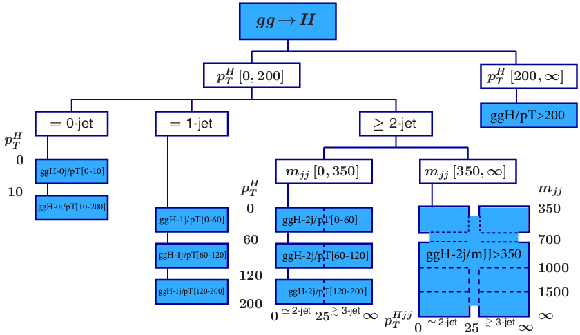
png pdf |
Figure 1:
Binning of the gluon fusion production in the STXS Stage 1.1 approach [25]. |

png pdf |
Figure 2:
Binning of the electroweak production (combines VBF and VH with hadronic V decay) in the STXS Stage 1.1 approach [25]. |

png pdf |
Figure 3:
Binning of the VH production with leptonic V decay (combining WH, ZH, and gluon fusion ZH production) in the STXS Stage 1.1 approach [25]. |

png pdf |
Figure 4:
Signal relative purity of the event categories in terms of the seven main production mechanisms of the Higgs boson in a 118 <m4ℓ< 130 GeV mass window. The WH, ZH and tˉtH processes are split according to the decay of associated objects, whereby X denotes anything other than an electron or muon. |
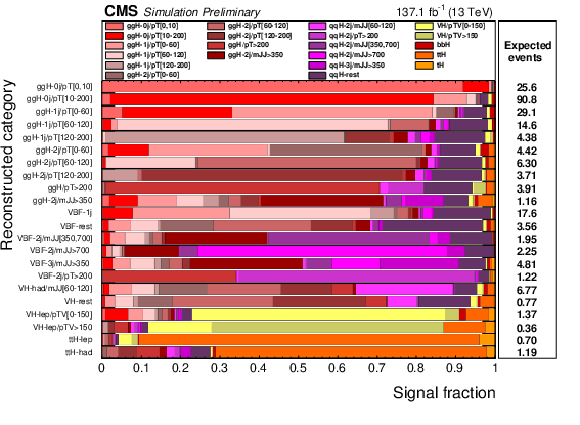
png pdf |
Figure 5:
Signal relative purity of the 22 event sub-categories in terms of the STXS Stage 1.1 Bins in a 118 <m4ℓ< 130 GeV mass window. |
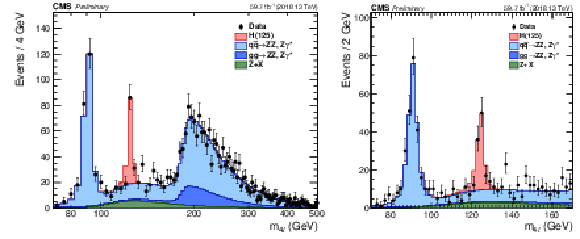
png pdf |
Figure 6:
Distribution of the reconstructed four-lepton invariant mass m4ℓ up to 500 GeV (left) and the low-mass range (right), with 2018 data. Points with error bars represent the data and stacked histograms represent expected distributions of the signal and background processes. The SM Higgs boson signal with mH= 125 GeV, denoted as H(125), and the ZZ backgrounds are normalized to the SM expectation, the Z+X background to the estimation from data. The order in perturbation theory used for the normalization of the irreducible backgrounds is described in Section 7.1. |

png pdf |
Figure 6-a:
Distribution of the reconstructed four-lepton invariant mass m4ℓ up to 500 GeV, with 2018 data. Points with error bars represent the data and stacked histograms represent expected distributions of the signal and background processes. The SM Higgs boson signal with mH= 125 GeV, denoted as H(125), and the ZZ backgrounds are normalized to the SM expectation, the Z+X background to the estimation from data. The order in perturbation theory used for the normalization of the irreducible backgrounds is described in Section 7.1. |
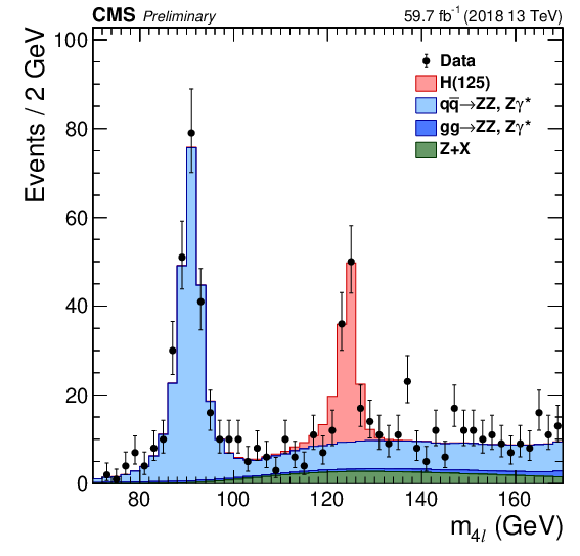
png pdf |
Figure 6-b:
Distribution of the reconstructed four-lepton invariant mass m4ℓ in the low-mass range, with 2018 data. Points with error bars represent the data and stacked histograms represent expected distributions of the signal and background processes. The SM Higgs boson signal with mH= 125 GeV, denoted as H(125), and the ZZ backgrounds are normalized to the SM expectation, the Z+X background to the estimation from data. The order in perturbation theory used for the normalization of the irreducible backgrounds is described in Section 7.1. |

png pdf |
Figure 7:
Distribution of the reconstructed four-lepton invariant mass m4ℓ up to 500 GeV (left) and the low-mass range (right), with full Run 2 data. Points with error bars represent the data and stacked histograms represent expected distributions of the signal and background processes. The SM Higgs boson signal with mH= 125 GeV, denoted as H(125), and the ZZ backgrounds are normalized to the SM expectation, the Z+X background to the estimation from data. The order in perturbation theory used for the normalization of the irreducible backgrounds is described in Section 7.1. |
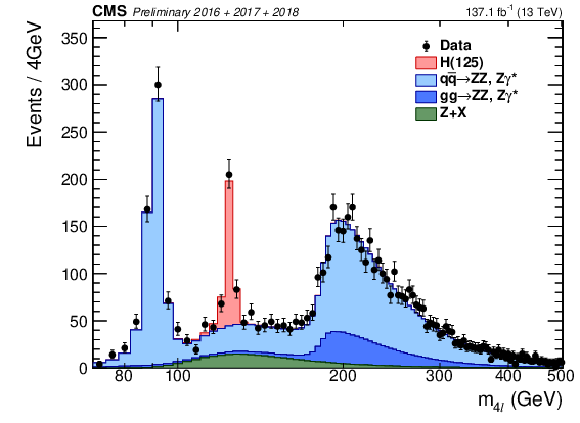
png pdf |
Figure 7-a:
Distribution of the reconstructed four-lepton invariant mass m4ℓ up to 500 GeV, with full Run 2 data. Points with error bars represent the data and stacked histograms represent expected distributions of the signal and background processes. The SM Higgs boson signal with mH= 125 GeV, denoted as H(125), and the ZZ backgrounds are normalized to the SM expectation, the Z+X background to the estimation from data. The order in perturbation theory used for the normalization of the irreducible backgrounds is described in Section 7.1. |
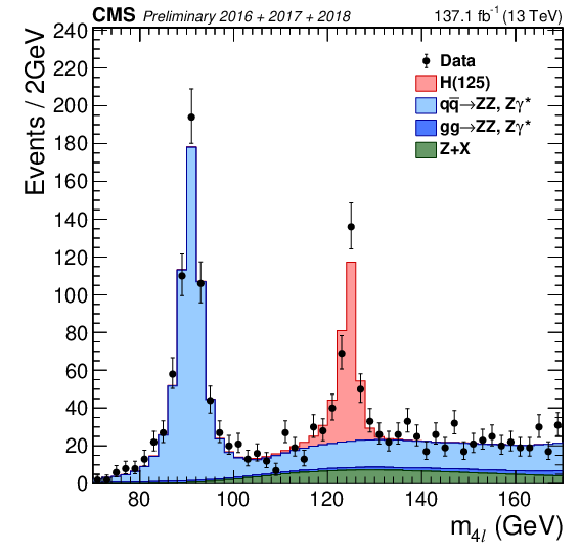
png pdf |
Figure 7-b:
Distribution of the reconstructed four-lepton invariant mass m4ℓ in the low-mass range, with full Run 2 data. Points with error bars represent the data and stacked histograms represent expected distributions of the signal and background processes. The SM Higgs boson signal with mH= 125 GeV, denoted as H(125), and the ZZ backgrounds are normalized to the SM expectation, the Z+X background to the estimation from data. The order in perturbation theory used for the normalization of the irreducible backgrounds is described in Section 7.1. |
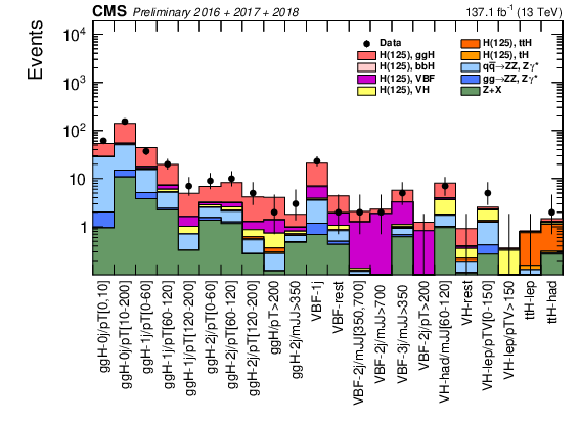
png pdf |
Figure 8:
Distributions of the expected and observed number of events for all Stage 1.1 sub-categories described in Section 6.2 in the mass region 118 <m4ℓ< 130 GeV with Run 2 data. Points with error bars represent the data and stacked histograms represent the expected numbers of the signal and background events. The different SM Higgs boson signal production modes with mH= 125 GeV, denoted as H(125), and the ZZ backgrounds are normalized to the SM expectation, the Z+X background to the estimation from data. The order in perturbation theory used for the normalization of the irreducible backgrounds is described in Section 7.1. |

png pdf |
Figure 9:
Distribution of the Z1 (left) and Z2 (center) reconstructed masses and correlation between the two (right) in the mass region 118 <m4ℓ< 130 GeV, with 2018 data. The stacked histograms and the gray scale represent expected distributions of the signal and background processes, and points represent the data. The SM Higgs boson signal with mH= 125 GeV, denoted as H(125), and the ZZ backgrounds are normalized to the SM expectation, the Z+X background to the estimation from data. The order in perturbation theory used for the normalization of the irreducible backgrounds is described in Section 7.1. |

png pdf |
Figure 9-a:
Distribution of the Z1 reconstructed mass in the mass region 118 <m4ℓ< 130 GeV, with 2018 data. The stacked histograms represent expected distributions of the signal and background processes, and points represent the data. The SM Higgs boson signal with mH= 125 GeV, denoted as H(125), and the ZZ backgrounds are normalized to the SM expectation, the Z+X background to the estimation from data. The order in perturbation theory used for the normalization of the irreducible backgrounds is described in Section 7.1. |
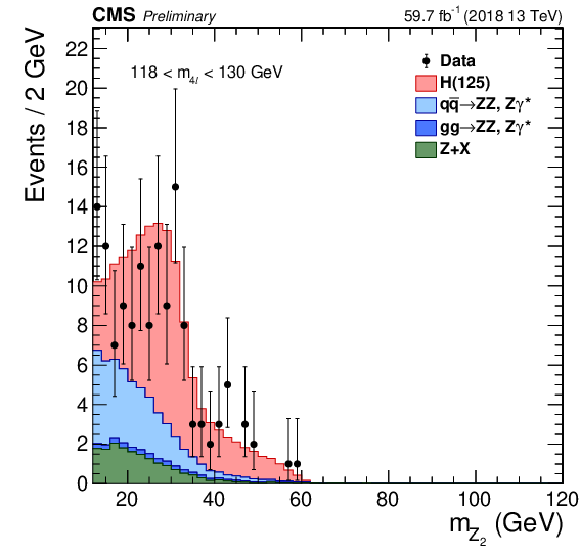
png pdf |
Figure 9-b:
Distribution of the Z2 reconstructed mass in the mass region 118 <m4ℓ< 130 GeV, with 2018 data. The stacked histograms represent expected distributions of the signal and background processes, and points represent the data. The SM Higgs boson signal with mH= 125 GeV, denoted as H(125), and the ZZ backgrounds are normalized to the SM expectation, the Z+X background to the estimation from data. The order in perturbation theory used for the normalization of the irreducible backgrounds is described in Section 7.1. |
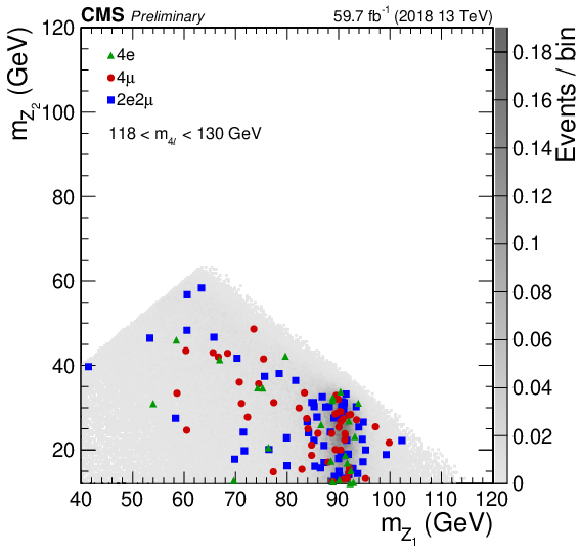
png pdf |
Figure 9-c:
Correlation between Z1 and Z2 in the mass region 118 <m4ℓ< 130 GeV, with 2018 data. The gray scale represents the expected distribution of the signal, and points represent the data. |

png pdf |
Figure 10:
Distribution of categorization discriminants in the mass region 118 <m4ℓ< 130 GeV, with 2018 data: (left) D2jet, (middle) D1jet, (right) DVH=max(DWH,DZH). Points with error bars represent the data and stacked histograms represent expected distributions of the signal and background processes. The SM Higgs boson signal with mH= 125 GeV, denoted as H(125), and the ZZ backgrounds are normalized to the SM expectation, the Z+X background to the estimation from data. The vertical gray dashed lines denote the working points used in the event categorization. The SM Higgs boson signal is separated into two components: the production mode which is targeted by the specific discriminant, and other production modes, where the gluon fusion process dominates. The order in perturbation theory used for the normalization of the irreducible backgrounds is described in Section 7.1. |

png pdf |
Figure 10-a:
Distribution of the D2jet categorization discriminant in the mass region 118 <m4ℓ< 130 GeV, with 2018 data. Points with error bars represent the data and stacked histograms represent expected distributions of the signal and background processes. The SM Higgs boson signal with mH= 125 GeV, denoted as H(125), and the ZZ backgrounds are normalized to the SM expectation, the Z+X background to the estimation from data. The vertical gray dashed lines denote the working points used in the event categorization. The SM Higgs boson signal is separated into two components: the production mode which is targeted by the specific discriminant, and other production modes, where the gluon fusion process dominates. The order in perturbation theory used for the normalization of the irreducible backgrounds is described in Section 7.1. |

png pdf |
Figure 10-b:
Distribution of the D1jet categorization discriminant in the mass region 118 <m4ℓ< 130 GeV, with 2018 data. Points with error bars represent the data and stacked histograms represent expected distributions of the signal and background processes. The SM Higgs boson signal with mH= 125 GeV, denoted as H(125), and the ZZ backgrounds are normalized to the SM expectation, the Z+X background to the estimation from data. The vertical gray dashed lines denote the working points used in the event categorization. The SM Higgs boson signal is separated into two components: the production mode which is targeted by the specific discriminant, and other production modes, where the gluon fusion process dominates. The order in perturbation theory used for the normalization of the irreducible backgrounds is described in Section 7.1. |

png pdf |
Figure 10-c:
Distribution of the DVH=max(DWH,DZH) categorization discriminant in the mass region 118 <m4ℓ< 130 GeV, with 2018 data. Points with error bars represent the data and stacked histograms represent expected distributions of the signal and background processes. The SM Higgs boson signal with mH= 125 GeV, denoted as H(125), and the ZZ backgrounds are normalized to the SM expectation, the Z+X background to the estimation from data. The vertical gray dashed lines denote the working points used in the event categorization. The SM Higgs boson signal is separated into two components: the production mode which is targeted by the specific discriminant, and other production modes, where the gluon fusion process dominates. The order in perturbation theory used for the normalization of the irreducible backgrounds is described in Section 7.1. |

png pdf |
Figure 11:
Distribution of three different kinematic discriminants versus m4ℓ, with 2018 data: Dkinbkg (left), DVBF+decbkg (middle) and DVH+decbkg (right) shown in the mass region 100 <m4ℓ< 170 GeV. The gray scale represents the expected total number of ZZ and Z+X background and SM Higgs boson signal events for mH= 125 GeV. The points show the data and the horizontal bars represent the measured event-by-event mass uncertainties. Different marker styles are used to denote the categorization of the events. |
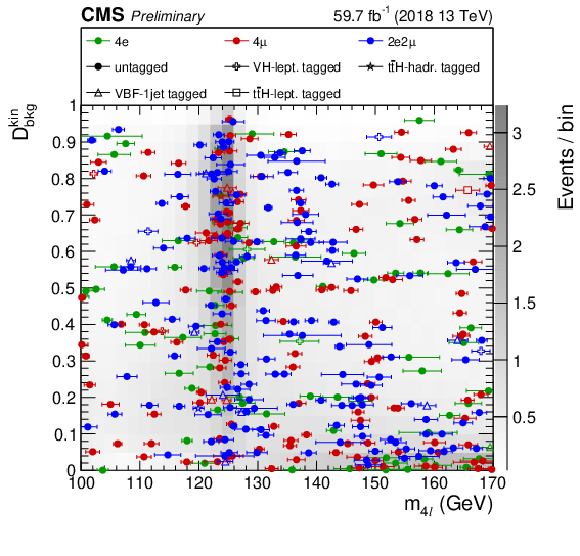
png pdf |
Figure 11-a:
Distribution of the Dkinbkg kinematic discriminant versus m4ℓ, with 2018 data, shown in the mass region 100 <m4ℓ< 170 GeV. The gray scale represents the expected total number of ZZ and Z+X background and SM Higgs boson signal events for mH= 125 GeV. The points show the data and the horizontal bars represent the measured event-by-event mass uncertainties. Different marker styles are used to denote the categorization of the events. |
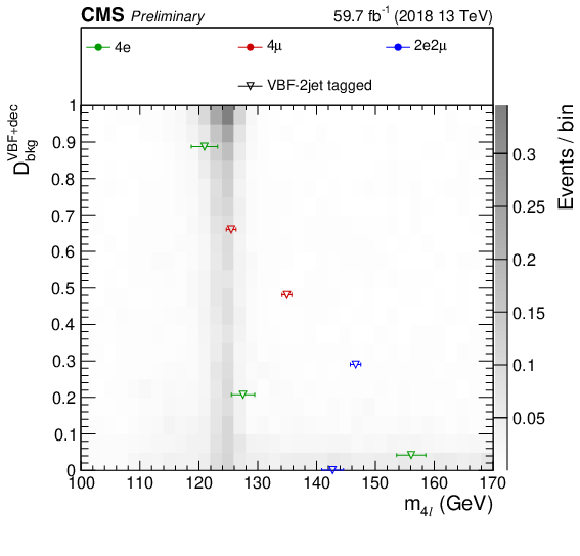
png pdf |
Figure 11-b:
Distribution of the DVBF+decbkg kinematic discriminant versus m4ℓ, with 2018 data, shown in the mass region 100 <m4ℓ< 170 GeV. The gray scale represents the expected total number of ZZ and Z+X background and SM Higgs boson signal events for mH= 125 GeV. The points show the data and the horizontal bars represent the measured event-by-event mass uncertainties. Different marker styles are used to denote the categorization of the events. |

png pdf |
Figure 11-c:
Distribution of the DVH+decbkg kinematic discriminant versus m4ℓ, with 2018 data, shown in the mass region 100 <m4ℓ< 170 GeV. The gray scale represents the expected total number of ZZ and Z+X background and SM Higgs boson signal events for mH= 125 GeV. The points show the data and the horizontal bars represent the measured event-by-event mass uncertainties. Different marker styles are used to denote the categorization of the events. |

png pdf |
Figure 12:
Distribution of kinematic discriminants in the mass region 118 <m4ℓ< 130 GeV, with 2018 data: (left) Dkinbkg, (middle) DVBF+decbkg, (right) DVH+decbkg. Points with error bars represent the data and stacked histograms represent expected distributions of the signal and background processes. The SM Higgs boson signal with mH= 125 GeV, denoted as H(125), and the ZZ backgrounds are normalized to the SM expectation, the Z+X background to the estimation from data. The SM Higgs boson signal is separated into two components: the production mode which is targeted by the specific discriminant, and other production modes, where the gluon fusion process dominates. |

png pdf |
Figure 12-a:
Distribution of the Dkinbkg kinematic discriminant in the mass region 118 <m4ℓ< 130 GeV, with 2018 data. Points with error bars represent the data and stacked histograms represent expected distributions of the signal and background processes. The SM Higgs boson signal with mH= 125 GeV, denoted as H(125), and the ZZ backgrounds are normalized to the SM expectation, the Z+X background to the estimation from data. The SM Higgs boson signal is separated into two components: the production mode which is targeted by the specific discriminant, and other production modes, where the gluon fusion process dominates. |
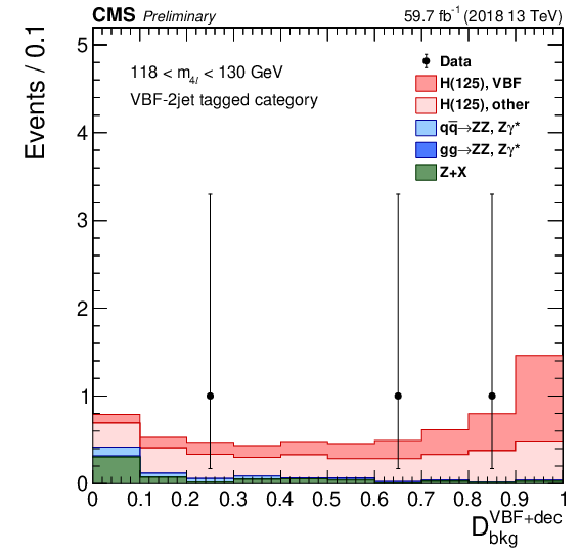
png pdf |
Figure 12-b:
Distribution of the DVBF+decbkg kinematic discriminant in the mass region 118 <m4ℓ< 130 GeV, with 2018 data. Points with error bars represent the data and stacked histograms represent expected distributions of the signal and background processes. The SM Higgs boson signal with mH= 125 GeV, denoted as H(125), and the ZZ backgrounds are normalized to the SM expectation, the Z+X background to the estimation from data. The SM Higgs boson signal is separated into two components: the production mode which is targeted by the specific discriminant, and other production modes, where the gluon fusion process dominates. |

png pdf |
Figure 12-c:
Distribution of the DVH+decbkg kinematic discriminant in the mass region 118 <m4ℓ< 130 GeV, with 2018 data. Points with error bars represent the data and stacked histograms represent expected distributions of the signal and background processes. The SM Higgs boson signal with mH= 125 GeV, denoted as H(125), and the ZZ backgrounds are normalized to the SM expectation, the Z+X background to the estimation from data. The SM Higgs boson signal is separated into two components: the production mode which is targeted by the specific discriminant, and other production modes, where the gluon fusion process dominates. |

png pdf |
Figure 13:
(Left) Results of likelihood scans for the signal-strength modifiers corresponding to the main SM Higgs boson production modes, compared to the combined μ shown as a vertical line. The horizontal bars and the filled band indicate the ± 1σ uncertainties. The uncertainties include both statistical and systematic sources. (Right) Result of the 2D likelihood scan for the μggH, tˉtH, bˉbH, tH and μVBF,VH signal-strength modifiers. The solid and dashed contours show the 68% and 95% CL regions, respectively. The cross indicates the best-fit value, and the diamond represents the expected value for the SM Higgs boson. |
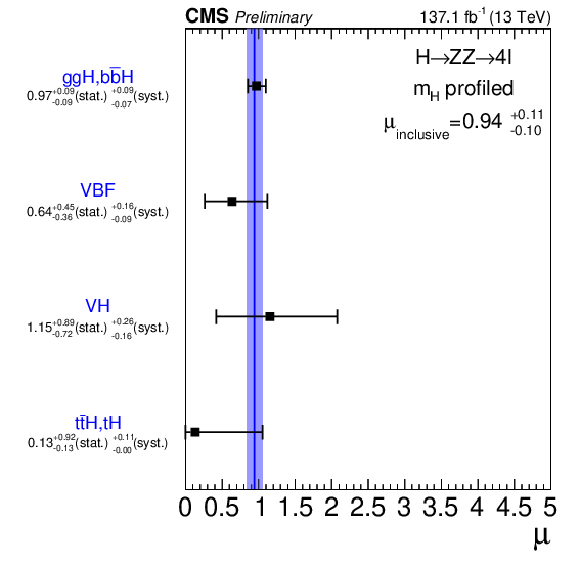
png pdf |
Figure 13-a:
Results of likelihood scans for the signal-strength modifiers corresponding to the main SM Higgs boson production modes, compared to the combined μ shown as a vertical line. The horizontal bars and the filled band indicate the ± 1σ uncertainties. The uncertainties include both statistical and systematic sources. |

png pdf |
Figure 13-b:
Result of the 2D likelihood scan for the μggH, tˉtH, bˉbH, tH and μVBF,VH signal-strength modifiers. The solid and dashed contours show the 68% and 95% CL regions, respectively. The cross indicates the best-fit value, and the diamond represents the expected value for the SM Higgs boson. |

png pdf |
Figure 14:
The ratios between measured cross sections and the SM prediction for Stage 0 Bins with mH profiled in the fit. The band around the vertical band shows the theoretical uncertainties on the SM cross section predictions for each Stage 0 Bin. Cross section values are reported for the best fit mass value mH= 125.1 GeV. |

png pdf |
Figure 15:
The ratios between measured cross sections and the SM prediction for Stage 1.1 Bins with mH profiled in the fit. The band around the vertical band shows the theoretical uncertainties on the SM cross section predictions for each Stage 1.1 Bin. The cross section ratios are constrained to be non-negative. The parameters whose best-fit values are at zero are known to have 68% CL intervals which slightly under-cover. Cross section values are reported for the best fit mass value mH= 125.1 GeV. |
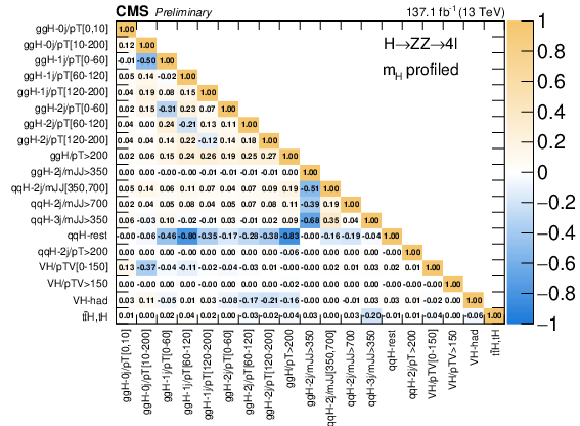
png pdf |
Figure 16:
Correlation matrix of the fitted signal strengths for Stage 1.1 Bins. |
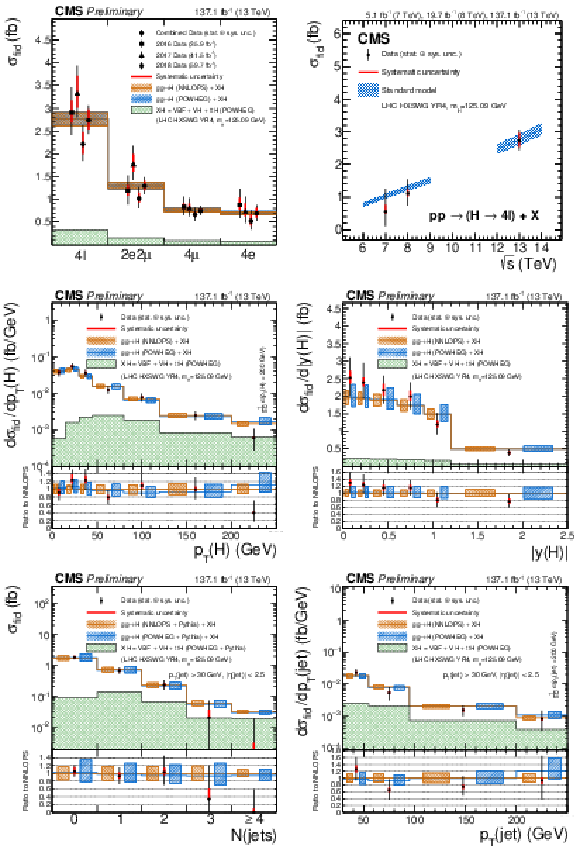
png pdf |
Figure 17:
The measured inclusive fiducial cross section in different final states (top left). The measured fiducial cross section as a function of √s (top right). The acceptance is calculated using POWHEG at √s= 13 TeV and HRes [63,65] at √s= 7 and 8 TeV and the total gluon fusion cross section and uncertainty are taken from Ref. [32]. The fiducial volume for √s= 6-9 TeV uses the lepton isolation definition from Ref. [21], while for √s= 12-14 TeV the definition described in the text is used. The results of the differential cross section measurement for pT(H) (middle left), |y(H)| (middle right) and N(jets) (bottom left), pT of the leading jet (bottom right). The acceptance and theoretical uncertainties in the differential bins are are calculated using POWHEG. The sub-dominant component of the the signal (VBF+VH+tˉtH) is denoted as XH. |
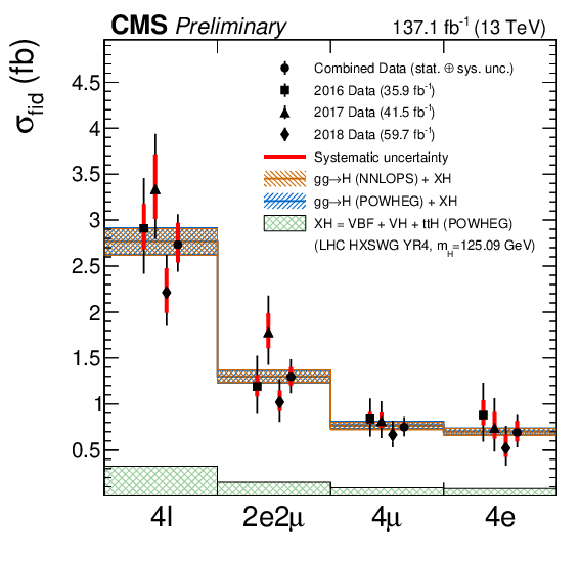
png pdf |
Figure 17-a:
The measured inclusive fiducial cross section in different final states. The acceptance is calculated using POWHEG at √s= 13 TeV and HRes [63,65] at √s= 7 and 8 TeV and the total gluon fusion cross section and uncertainty are taken from Ref. [32]. The fiducial volume for √s= 6-9 TeV uses the lepton isolation definition from Ref. [21], while for √s= 12-14 TeV the definition described in the text is used. |

png pdf |
Figure 17-b:
The measured fiducial cross section as a function of √s. The acceptance is calculated using POWHEG at √s= 13 TeV and HRes [63,65] at √s= 7 and 8 TeV and the total gluon fusion cross section and uncertainty are taken from Ref. [32]. The fiducial volume for √s= 6-9 TeV uses the lepton isolation definition from Ref. [21], while for √s= 12-14 TeV the definition described in the text is used. |

png pdf |
Figure 17-c:
The results of the differential cross section measurement for pT. The acceptance and theoretical uncertainties in the differential bins are are calculated using POWHEG. The sub-dominant component of the the signal (VBF+VH+tˉtH) is denoted as XH. |
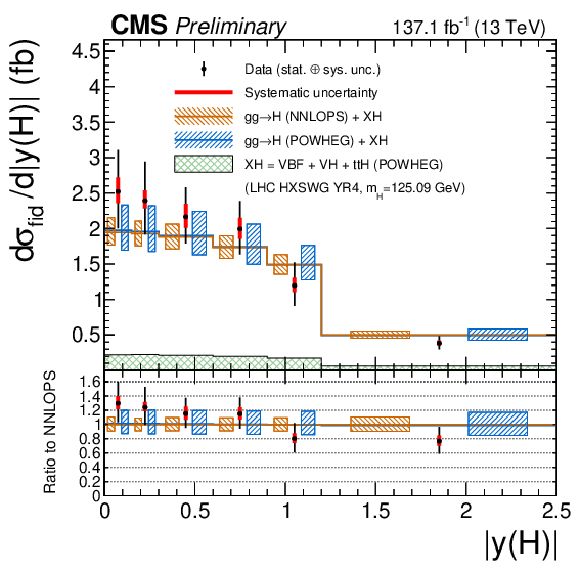
png pdf |
Figure 17-d:
The measured inclusive fiducial cross section in different final states (top left). The measured fiducial cross section as a function of √s (top right). The acceptance is calculated using POWHEG at √s= 13 TeV and HRes [63,65] at √s= 7 and 8 TeV and the total gluon fusion cross section and uncertainty are taken from Ref. [32]. The fiducial volume for √s= 6-9 TeV uses the lepton isolation definition from Ref. [21], while for √s= 12-14 TeV the definition described in the text is used. The results of the differential cross section measurement for pT(H) (middle left), |y(H)| (middle right) and N(jets) (bottom left), pT of the leading jet (bottom right). The acceptance and theoretical uncertainties in the differential bins are are calculated using POWHEG. The sub-dominant component of the the signal (VBF+VH+tˉtH) is denoted as XH. |

png pdf |
Figure 17-e:
The measured inclusive fiducial cross section in different final states (top left). The measured fiducial cross section as a function of √s (top right). The acceptance is calculated using POWHEG at √s= 13 TeV and HRes [63,65] at √s= 7 and 8 TeV and the total gluon fusion cross section and uncertainty are taken from Ref. [32]. The fiducial volume for √s= 6-9 TeV uses the lepton isolation definition from Ref. [21], while for √s= 12-14 TeV the definition described in the text is used. The results of the differential cross section measurement for pT(H) (middle left), |y(H)| (middle right) and N(jets) (bottom left), pT of the leading jet (bottom right). The acceptance and theoretical uncertainties in the differential bins are are calculated using POWHEG. The sub-dominant component of the the signal (VBF+VH+tˉtH) is denoted as XH. |

png pdf |
Figure 17-f:
The measured inclusive fiducial cross section in different final states (top left). The measured fiducial cross section as a function of √s (top right). The acceptance is calculated using POWHEG at √s= 13 TeV and HRes [63,65] at √s= 7 and 8 TeV and the total gluon fusion cross section and uncertainty are taken from Ref. [32]. The fiducial volume for √s= 6-9 TeV uses the lepton isolation definition from Ref. [21], while for √s= 12-14 TeV the definition described in the text is used. The results of the differential cross section measurement for pT(H) (middle left), |y(H)| (middle right) and N(jets) (bottom left), pT of the leading jet (bottom right). The acceptance and theoretical uncertainties in the differential bins are are calculated using POWHEG. The sub-dominant component of the the signal (VBF+VH+tˉtH) is denoted as XH. |
| Tables | |

png pdf |
Table 1:
The number of expected background and signal events and number of observed candidates after full analysis selection, for each final state, for the full mass range m4ℓ> 70 GeV and for an integrated luminosity of 59.7 fb−1. Signal and ZZ backgrounds are estimated from Monte Carlo simulation, Z+X is estimated from data. The uncertainties include both statistical and systematic sources. |

png pdf |
Table 2:
The number of expected background and signal events and number of observed candidates after full analysis selection, for each event category, for the mass range 118 <m4ℓ< 130 GeV and for an integrated luminosity of 137.1 fb−1. The yields are given for the different production modes. Signal and ZZ backgrounds are estimated from Monte Carlo simulation, Z+X is estimated from data. The uncertainties include both statistical and systematic sources. |

png pdf |
Table 3:
Expected and observed signal-strength modifiers with Run 2 data. The observed uncertainty numbers are broken into statistical (first) and systematic (second) sources. |
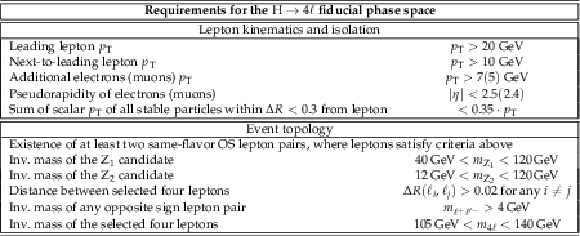
png pdf |
Table 4:
Summary of requirements used in the definition of the fiducial phase space for the H→4ℓ cross section measurements. |

png pdf |
Table 5:
Summary of different SM signal models. For all production modes the values given are for mH= 125 GeV. The uncertainties listed are statistical only, and the statistical uncertainty on the acceptance is ∼0.001. |
| Summary |
| Several measurements of Higgs (H) boson production in the four-lepton final state at √s= 13 TeV have been presented, using data samples corresponding to an integrated luminosity of 137.1 fb−1. The measured signal-strength modifier is μ= 0.94+0.07−0.07(stat.)+0.08−0.07(syst.) and integrated fiducial cross section is measured to be σfid.= 2.73+0.23−0.22(stat.)+0.24−0.19(syst.) fb. The signal-strength modifiers for the main H boson production modes are also constrained. Measurements of the simplified template cross sections, designed to quantify the different H boson production processes in specific regions of phase space, have been measured for the first time with the Stage 1.1 recommendation. Differential cross sections as a function of the pT and rapidity of the H boson, the number of associated jets, and the pT of the leading associated jet are determined. All results are consistent, within their uncertainties, with the expectations for the Standard Model H boson. |
| Additional Figures | |

png pdf |
Additional Figure 1:
Event display for a tˉtH event candidate. |
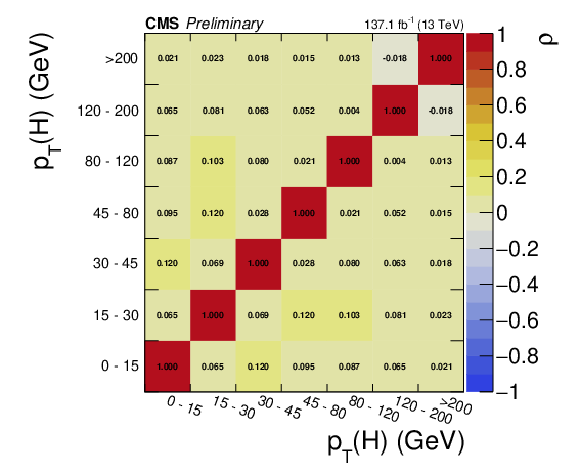
png pdf |
Additional Figure 2:
Bin-to-bin correlation matrix of the pT(H) spectrum. |
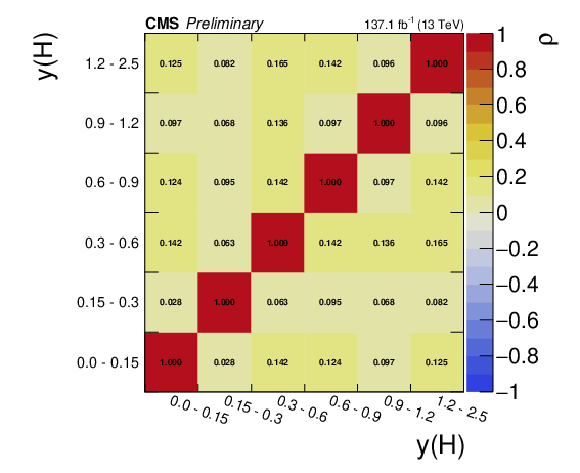
png pdf |
Additional Figure 3:
Bin-to-bin correlation matrix of the y(H) spectrum. |
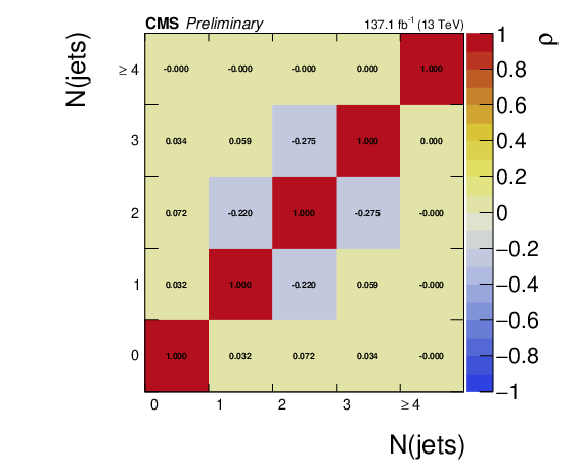
png pdf |
Additional Figure 4:
Bin-to-bin correlation matrix of the N(jets) spectrum. |
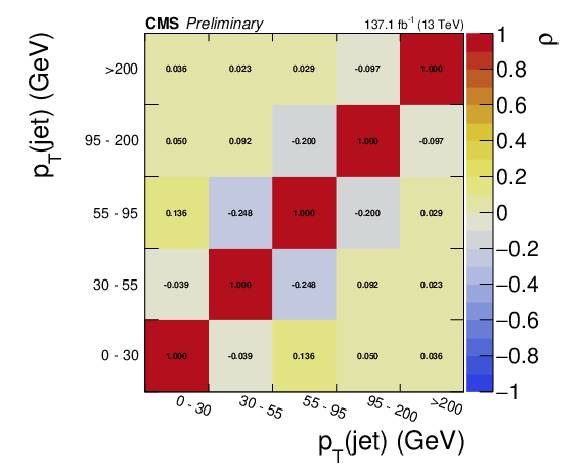
png pdf |
Additional Figure 5:
Bin-to-bin correlation matrix of the pT(jet) spectrum. |
| Additional Tables | |
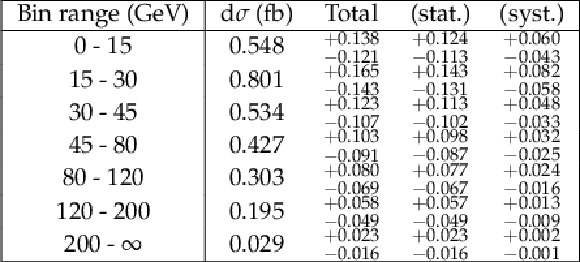
png pdf |
Additional Table 1:
Differential cross section results for the pT(H) observable. |
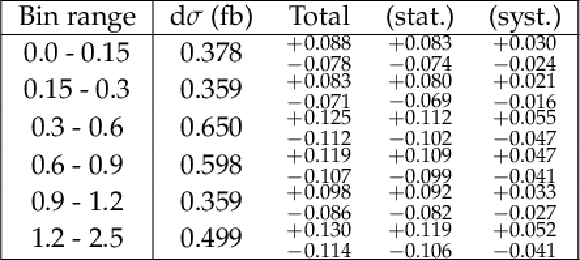
png pdf |
Additional Table 2:
Differential cross section results for the y(H) observable. |
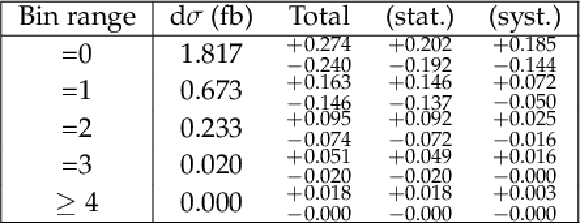
png pdf |
Additional Table 3:
Differential cross section results for the N(jets) observable. |
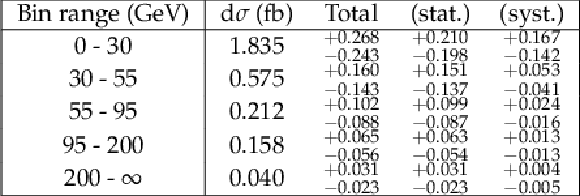
png pdf |
Additional Table 4:
Differential cross section results for the pT(jet) observable. |
| References | ||||
| 1 | CMS Collaboration | Observation of a new boson at a mass of 125 GeV with the CMS experiment at the LHC | PLB 716 (2012) 30 | CMS-HIG-12-028 1207.7235 |
| 2 | ATLAS Collaboration | Observation of a new particle in the search for the Standard Model Higgs boson with the ATLAS detector at the LHC | PLB 716 (2012) 1 | 1207.7214 |
| 3 | F. Englert and R. Brout | Broken Symmetry and the Mass of Gauge Vector Mesons | PRL 13 (1964) 321 | |
| 4 | P. W. Higgs | Broken symmetries, massless particles and gauge fields | PL12 (1964) 132 | |
| 5 | P. W. Higgs | Broken Symmetries and the Masses of Gauge Bosons | PRL 13 (1964) 508 | |
| 6 | G. Guralnik, C. Hagen, and T. Kibble | Global Conservation Laws and Massless Particles | PRL 13 (1964) 585 | |
| 7 | P. W. Higgs | Spontaneous Symmetry Breakdown without Massless Bosons | PR145 (1966) 1156 | |
| 8 | T. Kibble | Symmetry breaking in nonAbelian gauge theories | PR155 (1967) 1554 | |
| 9 | CMS Collaboration | Precise determination of the mass of the Higgs boson and tests of compatibility of its couplings with the standard model predictions using proton collisions at 7 and 8 TeV | EPJC 75 (2015) 212 | CMS-HIG-14-009 1412.8662 |
| 10 | ATLAS Collaboration | Measurements of the Higgs boson production and decay rates and coupling strengths using pp collision data at √s= 7 and 8 TeV in the ATLAS experiment | EPJC 76 (2016) | 1507.04548 |
| 11 | ATLAS and CMS Collaborations | Combined Measurement of the Higgs Boson Mass in pp Collisions at √s= 7 and 8 TeV with the ATLAS and CMS Experiments | PRL 114 (2015) 191803 | 1503.07589 |
| 12 | ATLAS and CMS Collaborations | Measurements of the Higgs boson production and decay rates and constraints on its couplings from a combined ATLAS and CMS analysis of the LHC pp collision data at √s= 7 and 8 TeV | JHEP 08 (2016) 45 | 1606.02266 |
| 13 | CMS Collaboration | Combined meaurements of the Higgs boson's couplings at √s= 13 TeV | ||
| 14 | CMS Collaboration | Measurements of properties of the Higgs boson decaying into the four-lepton final state in pp collisions at √s= 13 TeV | JHEP 11 (2017) 047 | CMS-HIG-16-041 1706.09936 |
| 15 | CMS Collaboration | Measurements of properties of the Higgs boson in the four-lepton final state at √s= 13 TeV | CMS-PAS-HIG 18-001 | CMS-PAS-HIG-18-001 |
| 16 | CMS Collaboration | Measurement of the properties of a Higgs boson in the four-lepton final state | PRD 89 (2014) 092007 | CMS-HIG-13-002 1312.5353 |
| 17 | CMS Collaboration | Study of the Mass and Spin-Parity of the Higgs Boson Candidate via Its Decays to Z Boson Pairs | PRL 110 (2013) 081803 | CMS-HIG-12-041 1212.6639 |
| 18 | CMS Collaboration | Constraints on the spin-parity and anomalous HVV couplings of the Higgs boson in proton collisions at 7 and 8 TeV | PRD 92 (2015) 012004 | CMS-HIG-14-018 1411.3441 |
| 19 | CMS Collaboration | Constraints on the Higgs boson width from off-shell production and decay to Z-boson pairs | PLB 736 (2014) 64 | CMS-HIG-14-002 1405.3455 |
| 20 | CMS Collaboration | Limits on the Higgs boson lifetime and width from its decay to four charged leptons | PRD 92 (2015) 072010 | CMS-HIG-14-036 1507.06656 |
| 21 | CMS Collaboration | Measurement of differential and integrated fiducial cross sections for Higgs boson production in the four-lepton decay channel in pp collisions at √s= 7 and 8 TeV | JHEP 04 (2016) 005 | CMS-HIG-14-028 1512.08377 |
| 22 | CMS Collaboration | Constraints on anomalous Higgs boson couplings using production and decay information in the four-lepton final state | PLB775 (2017) 1--24 | CMS-HIG-17-011 1707.00541 |
| 23 | CMS Collaboration | Measurements of the Higgs boson width and anomalous HVV couplings from on-shell and off-shell production in the four-lepton final state | CMS-HIG-18-002 1901.00174 |
|
| 24 | LHC Higgs Cross Section Working Group | Handbook of LHC Higgs Cross Sections: 4. Deciphering the Nature of the Higgs Sector | CERN-2017-002-M (CERN, Geneva, 2016) | 1610.07922 |
| 25 | LHCXSWG | Simplified template cross section, stage 1.1 | LHCXSWG Twiki (2018) | |
| 26 | A. Dominguez et al. | CMS Technical Design Report for the Pixel Detector Upgrade | CERN-LHCC-2012-016. CMS-TDR-11, Sep | |
| 27 | CMS Collaboration | The CMS experiment at the CERN LHC | JINST 3 (2008) S08004 | CMS-00-001 |
| 28 | S. Alioli, P. Nason, C. Oleari, and E. Re | NLO vector-boson production matched with shower in POWHEG | JHEP 07 (2008) 060 | 0805.4802 |
| 29 | P. Nason | A new method for combining NLO QCD with shower Monte Carlo algorithms | JHEP 11 (2004) 040 | hep-ph/0409146 |
| 30 | S. Frixione, P. Nason, and C. Oleari | Matching NLO QCD computations with parton shower simulations: the POWHEG method | JHEP 11 (2007) 070 | 0709.2092 |
| 31 | G. Luisoni, P. Nason, C. Oleari, and F. Tramontano | HW±/HZ + 0 and 1 jet at NLO with the POWHEG BOX interfaced to GoSam and their merging within MiNLO | JHEP 10 (2013) 1 | 1306.2542 |
| 32 | C. Anastasiou et al. | High precision determination of the gluon fusion Higgs boson cross-section at the LHC | JHEP 2016 (2016), no. 5, 1 | 1602.00695 |
| 33 | Y. Gao et al. | Spin determination of single-produced resonances at hadron colliders | PRD 81 (2010) 075022 | 1001.3396 |
| 34 | S. Bolognesi et al. | On the spin and parity of a single-produced resonance at the LHC | PRD 86 (2012) 095031 | 1208.4018 |
| 35 | I. Anderson et al. | Constraining anomalous HVV interactions at proton and lepton colliders | PRD 89 (2014) 035007 | 1309.4819 |
| 36 | A. V. Gritsan, R. Roentsch, M. Schulze, and M. Xiao | Constraining anomalous Higgs boson couplings to the heavy flavor fermions using matrix element techniques | PRD94 (2016), no. 5, 055023 | 1606.03107 |
| 37 | J. M. Campbell and R. K. Ellis | MCFM for the Tevatron and the LHC | NPPS 205 (2010) 10 | 1007.3492 |
| 38 | NNPDF Collaboration | Parton distributions from high-precision collider data | EPJC 77 (2017) 663 | 1706.00428 |
| 39 | T. Sjostrand et al. | An introduction to pythia 8.2 | Computer Physics Communications 191 (2015) 159 | |
| 40 | CMS Collaboration | Event generator tunes obtained from underlying event and multiparton scattering measurements | EPJC 76 (2016) 155 | CMS-GEN-14-001 1512.00815 |
| 41 | GEANT4 Collaboration | GEANT4: a simulation toolkit | NIMA 506 (2003) 250 | |
| 42 | J. Allison et al. | Geant4 developments and applications | IEEE Trans. Nucl. Sci. 53 (2006) 270 | |
| 43 | CMS Collaboration | Particle-flow reconstruction and global event description with the cms detector | JINST 12 (2017) P10003 | CMS-PRF-14-001 1706.04965 |
| 44 | CMS Collaboration | Performance of CMS muon reconstruction in pp collision events at √s= 7 TeV | JINST 7 (2012) P10002 | CMS-MUO-10-004 1206.4071 |
| 45 | CMS Collaboration | Performance of electron reconstruction and selection with the CMS detector in proton-proton collisions at √s= 8 TeV | JINST 10 (2015) P06005 | CMS-EGM-13-001 1502.02701 |
| 46 | CMS Collaboration | Electron and Photon performance in CMS with the full 2017 data sample and additional highlights for the CALOR 2018 conference | CMS Detector Performance Summary CMS-DPS-2018/2017 | |
| 47 | T. Chen and C. Guestrin | XGBoost: A Scalable Tree Boosting System | 1603.02754 | |
| 48 | M. Cacciari, G. P. Salam, and G. Soyez | The anti-kt jet clustering algorithm | JHEP 04 (2008) 063 | 0802.1189 |
| 49 | M. Cacciari, G. P. Salam, and G. Soyez | FastJet user manual | EPJC 72 (2012) 1896 | 1111.6097 |
| 50 | CMS Collaboration | Jet energy scale and resolution in the CMS experiment in pp collisions at 8 TeV | JINST 12 (2017), no. 02, P02014 | CMS-JME-13-004 1607.03663 |
| 51 | CMS Collaboration | Jet algorithms performance in 13 TeV data | CMS-PAS-JME-16-003 | CMS-PAS-JME-16-003 |
| 52 | CMS Collaboration | Identification of heavy-flavour jets with the CMS detector in pp collisions at 13 TeV | JINST 13 (2018), no. 05, P05011 | CMS-BTV-16-002 1712.07158 |
| 53 | Particle Data Group Collaboration | Review of Particle Physics | CPC40 (2016), no. 10, 100001 | |
| 54 | CMS Collaboration | Search for a Higgs Boson in the Mass Range from 145 to 1000 GeV Decaying to a Pair of W or Z Bosons | JHEP 10 (2015) 144 | CMS-HIG-13-031 1504.00936 |
| 55 | M. Grazzini, S. Kallweit, and D. Rathlev | ZZ production at the LHC: Fiducial cross sections and distributions in NNLO QCD | PLB 750 (2015) 407 -- 410 | 1507.06257 |
| 56 | A. Bierweiler, T. Kasprzik, and J. H. Kuhn | Vector-boson pair production at the LHC to O(α3) accuracy | JHEP 12 (2013) 071 | 1305.5402 |
| 57 | M. Bonvini et al. | Signal-background interference effects in gg→H→WW beyond leading order | PRD 88 (2013) 034032 | 1304.3053 |
| 58 | K. Melnikov and M. Dowling | Production of two Z-bosons in gluon fusion in the heavy top quark approximation | PLB 744 (2015) 43 | 1503.01274 |
| 59 | C. S. Li, H. T. Li, D. Y. Shao, and J. Wang | Soft gluon resummation in the signal-background interference process of gg(→h∗)→ZZ~ | 1504.02388 | |
| 60 | G. Passarino | Higgs CAT | EPJC 74 (2014) 2866 | 1312.2397 |
| 61 | S. Catani and M. Grazzini | An NNLO subtraction formalism in hadron collisions and its application to Higgs boson production at the LHC | PRL 98 (2007) 222002 | hep-ph/0703012 |
| 62 | M. Grazzini | NNLO predictions for the Higgs boson signal in the H → WW →ℓνℓν and H→ ZZ →4ℓ decay channels | JHEP 02 (2008) 043 | 0801.3232 |
| 63 | M. Grazzini and H. Sargsyan | Heavy-quark mass effects in Higgs boson production at the LHC | JHEP 09 (2013) 129 | 1306.4581 |
| 64 | L. Landau | On the energy loss of fast particles by ionization | J. Phys. (USSR) 8 (1944)201 | |
| 65 | D. de Florian, G. Ferrera, M. Grazzini, and D. Tommasini | Higgs boson production at the LHC: transverse momentum resummation effects in the H→γγ, H→WW→ℓνℓν and H→ZZ→4ℓ decay modes | JHEP 06 (2012) 132 | 1203.6321 |
| 66 | E. Bagnaschi, G. Degrassi, P. Slavich, and A. Vicini | Higgs production via gluon fusion in the POWHEG approach in the SM and in the MSSM | JHEP 02 (2012) 088 | 1111.2854 |
| 67 | K. Hamilton, P. Nason, E. Re, and G. Zanderighi | NNLOPS simulation of Higgs boson production | JHEP 10 (2013) 222 | 1309.0017 |
| 68 | F. Garwood | Fiducial Limits for the Poisson Distribution | Biometrika 28 (1936), no. 3-4, 437 | |
| 69 | ATLAS and CMS Collaborations, LHC Higgs Combination Group | Procedure for the lhc higgs boson search combination in summer 2011 | ATL-PHYS-PUB/CMS NOTE 2011-11, 2011/005, CERN | |
| 70 | G. Cowan, K. Cranmer, E. Gross, and O. Vitells | Asymptotic formulae for likelihood-based tests of new physics | EPJC 71 (2011) 1554 | 1007.1727 |
| 71 | CMS Collaboration | Measurement of differential cross sections for Higgs boson production in the diphoton decay channel in pp collisions at √s= 8 TeV | EPJC 76 (2015) 13 | CMS-HIG-14-016 1508.07819 |

|
Compact Muon Solenoid LHC, CERN |

|

|

|

|

|

|